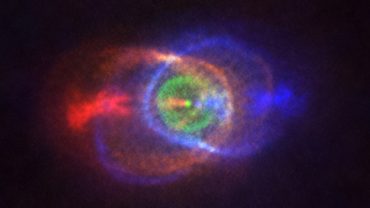
An example of a post common envelope binary star, as seen by the ALMA telescope. Image credit: ALMA (ESO/NAOJ/NRAO)
Amateur astronomers regularly make important contributions to astronomy research. That can be through observations of meteor showers, or images of solar system objects. But it’s not always about pretty pictures, and some amateurs also make measurements that feed into our understanding of a broad range of astronomical phenomena, providing a network of telescopes that far outnumbers the professional astronomers.
Ian Sharp is a member of a group of astronomers who have been making observations of something called “Post Common Envelope Binary” stars, two stars which have gone through an interesting phase of their evolution. The team carefully measure` the times at which one star appears to partially eclipse the other. By establishing when those eclipse vary differ from predictions the team can provide evidence to prove, or disprove, the existence of planets orbiting the stars.
This requires careful observation and analysis, which the team of astronomers have been undertaking for a number of years. Their research is published in the Monthly Notices of the Royal Astronomical Society, a scientific journal used and respected by professional astronomers. Ian also discusses what got him into amateur astronomy, and how that has changed over the decades.
You can read the research here on arxiv.org.





